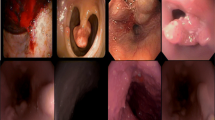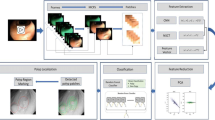Abstract
AI intelligent detection of colon polyp has been found as a highly popular research direction. Moreover, mainstream research places a focus on how to recognize colon polyp using a better neural network model architecture. The video employed for recognition will be considered the original video output by the endoscope. Through research, it was found that besides the prominent neural network architecture, more excellent video preprocessing algorithms can significantly increase the accuracy of recognition and location for colon polyp. As revealed by the research result, the relative highlight area attributed to uneven illumination and the absolute highlight area attributed to specular reflection are the main factors of the recognition of colon polyp by the neural network. To solve the problem above, all highlight areas are divided into four categories, i.e., the relative highlight area, the large absolute highlight area, the medium absolute highlight area and the small absolute highlight area. This study designs different restoration algorithms in accordance with the nature and characteristics of the respective categories. The relative highlight area can be corrected and restored using the two-dimensional (2d) gamma function. The large absolute highlight area will not be processed since it will not reduce the recognition accuracy of the neural network. The small absolute highlight area has a slight effect on the recognition accuracy of the neural network, so the surrounding color filling method will be adopted to restore the area. The medium absolute highlight area will be restored by the optimized Criminisi algorithm. The test is performed on four neural networks, i.e., the Unet, Unet++, ResUnet and ResUnet++. After the sample is processed by this algorithm, the results show that the recognition accuracy of colon polyps by four kinds of neural network is significantly improved. Compared with other image restoration algorithms that take tens of seconds, the image restoration algorithm in this study takes less than 90 ms, which obviously reduces the time, and can basically meet the real-time requirements of AI intelligent detection.












Similar content being viewed by others
References
Nadim, M., et al.: Computer vision and augmented reality in gastrointestinal endoscopy. Gastroenterol. Rep. 3, 179–184 (2015). (3,3(2015-7-1))
Misawa, M., Kudo, S., Mori, Y.: Current status and future perspective on artificial intelligence for lower endoscopy. Dig. Endosc. 33(2), 273–284 (2021)
Goyal, H., Mann, R., Gandhi, Z., et al.: Scope of artificial intelligence in screening and diagnosis of colorectal cancer. J. Clin. Med. 9(10), 3313 (2020)
Ahmad, O.F., Soares, A.S., Mazomenos, E.: Artificial intelligence and computer-aided diagnosis in colonoscopy: current evidence and future directions. Lancet Gastroenterol. Hepatol. 4(1), 71–80 (2019)
Ip, A., Dkb, C.: A robust real-time deep learning based automatic polyp detection system. Comput. Biol. Med. 134, 104519 (2021)
Ahmed, J., et al.: Direct access colonoscopy in primary care: Is it a safe and practical approach? Scott. Med. J. 58, 168–172 (2013)
Zheng, Y., et al.: Localisation of Colorectal Polyps by Convolutional Neural Network Features Learnt from White Light and Narrow Band Endoscopic Images of Multiple Databases. In: 2018 40th Annual International Conference of the IEEE Engineering in Medicine and Biology Society (EMBC) IEEE, (2018)
Jia, X., et al.: Automatic polyp recognition in colonoscopy images using deep learning and two-stage pyramidal feature prediction. IEEE Trans. Autom. Sci. Eng. 99, 1–15 (2020)
Liew, W.S., et al.: Automatic colonic polyp detection using integration of modified deep residual convolutional neural network and ensemble learning approaches. Comput. Methods Programs Biomed. 2, 106114 (2021)
Zhao, H., et al.: Pyramid Scene parsing network, IEEE Comput. Soc. (2016)
Liu, Z. C. , et al.: adaptive adjustment algorithm for non-uniform illumination images based on 2D gamma function. Transactions of Beijing Institute of Technology (2016)
Lin, L., et al.: An advanced total variation model in H-1 space for image inpainting. In: Seventh International Conference on Graphic and Image Processing International Society for Optics and Photonics, (2015)
Criminisi, Antonio, et al.: Region filling and object removal by exemplar-based image inpainting. IEEE Trans. Image Process. 13, 1200–1212 (2004)
Li, L., et al.: Image inpainting algorithm based on TV model and evolutionary algorithm. Soft Comput. 20(3), 885–893 (2016)
Criminisi, Antonio, et al.: Region filling and object removal by exemplar-based image inpainting. IEEE Trans. Image Process. 13, 1200–1212 (2004)
Buyssens, P., et al.: Exemplar-based Inpainting: Technical review and new heuristics for better geometric reconstructions. IEEE Trans. Image Process. Publ. IEEE Signal Process. Soc. 24(6), 1809–24 (2015)
Cao, J., et al.: Restoration of an ancient temple mural by a local search algorithm of an adaptive sample block. Herit. Sci. 7, 1 (2019)
Brelstaff, G., Blake, A.: Detecting specular reflections using lambertian constraints. Comput. Vis. Second International Conference on IEEE (1989)
Klinker, G.J. , Shafer, S.A., Kanade, T.: Using a color reflection model to separate highlights from object color. Proc. Int. Conf. Comput. Vis. pp 145–150 (1987)
Yeo, Heather L., et al.: Early-onset colorectal cancer is distinct from traditional colorectal cancer. Clin. Colorectal Cancer 16, 293 (2017)
Li, X., et al.: H-DenseUNet: hybrid densely connected UNet for liver and liver tumor segmentation from CT volumes. IEEE Trans. Med. Imag. pp 1–1 (2017)
Tulsani, A., Kumar, P., Pathan, S.: Automated segmentation of optic disc and optic cup for glaucoma assessment using improved UNET++ architecture. Biocybern. Biomed. Eng. 41, 18 (2021)
Wang, J., et al.: DA-ResUNet: a novel method for brain tumor segmentation based on U-Net with residual block and CBAM. In: Society of Photo-Optical Instrumentation Engineers (SPIE) Conference Series SPIE (2021)
Jha, D., et al.: ResUNet++: an advanced architecture for medical image segmentation. In: 21st IEEE International Symposium on Multimedia IEEE, (2019)
Fan, D.P., et al.: PraNet: Parallel Reverse Attention Network for Polyp Segmentation, (2020)
Author information
Authors and Affiliations
Corresponding author
Additional information
Publisher's Note
Springer Nature remains neutral with regard to jurisdictional claims in published maps and institutional affiliations.
Rights and permissions
Springer Nature or its licensor holds exclusive rights to this article under a publishing agreement with the author(s) or other rightsholder(s); author self-archiving of the accepted manuscript version of this article is solely governed by the terms of such publishing agreement and applicable law.
About this article
Cite this article
Feng, B., Xu, C. & An, Z. AI recognition preprocessing algorithm for polyp based on illumination equalization and highlight restoration. Int J Data Sci Anal 15, 217–230 (2023). https://doi.org/10.1007/s41060-022-00353-w
Received:
Accepted:
Published:
Issue Date:
DOI: https://doi.org/10.1007/s41060-022-00353-w




